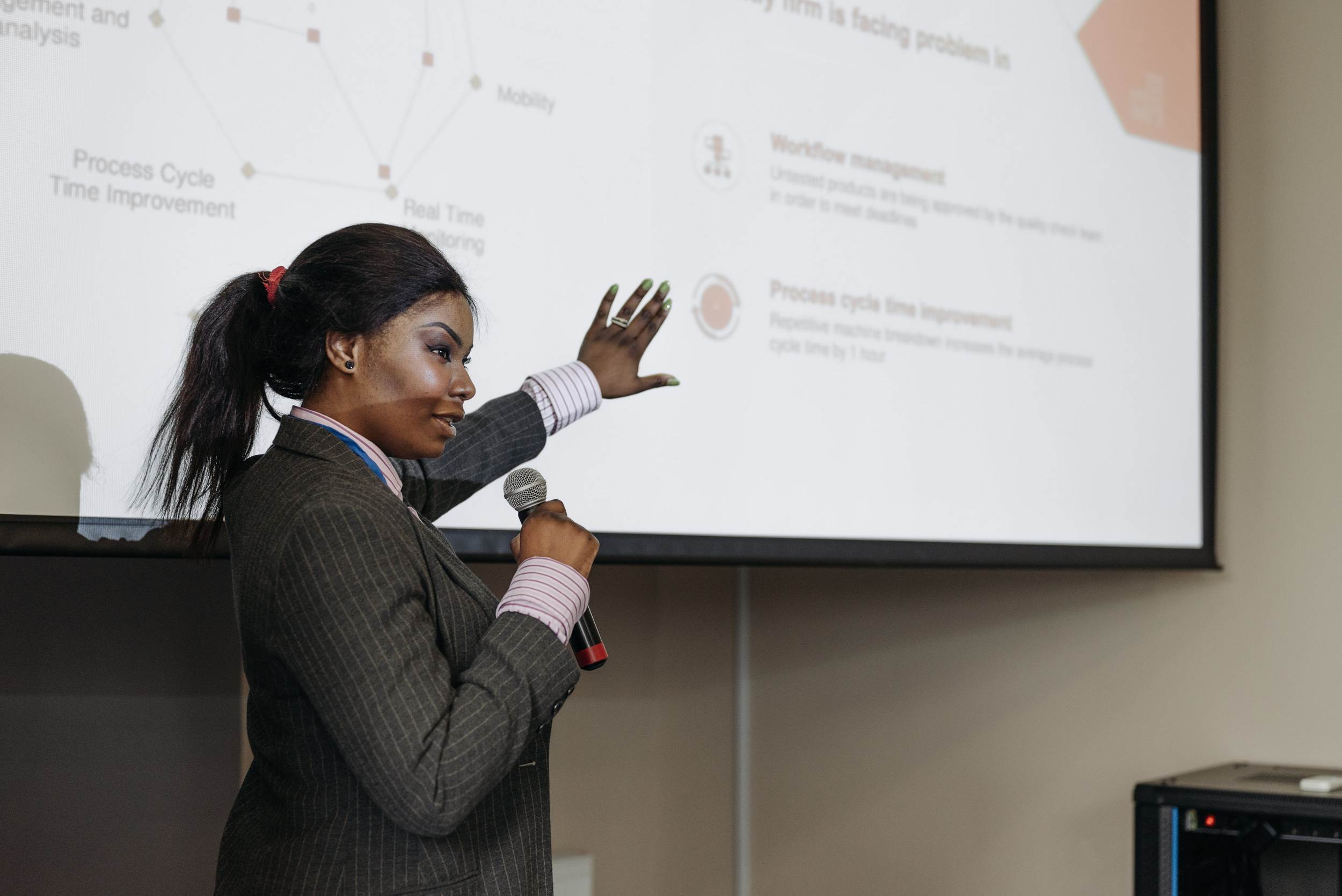Although this article is mainly written for speakers, event organizers can also benefit from it. Use it to familiarize yourself with everything that could go wrong, and how to handle various common technical grievances.
The success of your talk depends on many things, most of which you can influence in one way or another. The key is to step on the stage as prepared as possible. That means you've rehearsed your talk to a point where you can go through it without relying on your slides, and you've aligned it to the time slot allocated to you by the organizers of an event you're about to participate in. Don't underestimate the importance of the latter. Trying to squeeze a 45-minute talk into a 30-minute time slot will have one of two outcomes: your entire presentation will feel rushed and potentially confusing, or you'll get cut short and fail to deliver the intended message(s).
Things like that are entirely in your hands and completely dependent on your actions. However, as most seasoned speakers will tell you, sometimes your talk can be interrupted by unexpected technical issues, which you neither caused nor can fix. Such mishaps can escalate into a complete disaster. To make that much less likely, we'll go over the most common technical disturbances and what you can do if or when they occur.

We've broken this down into two scenarios: you're presenting from your laptop, or the organizer uses their laptop for presentations. Organizers who insist on using their equipment for presentations will usually contact you and ask that you send them your presentation. If you're unsure whether you can present from your laptop or not, consult with the event organizer.
You're presenting from a personal laptop
Many events will have you show up shortly before your time slot, plug in your laptop, and start the presentation. This is especially true for technically more demanding talks, as well as those where you want to do a demo of a product you're talking about. This approach is very convenient, as you can edit your presentation until the last minute and you're presenting in a completely familiar environment, but you still have to be mindful of a couple of details.
Bring your video adapter
HDMI is a universal video interface for projectors, televisions, video mixers, and all other video devices that might be present at the venue. For seamless connectivity, it's expected that your laptop is equipped with a HDMI output. Forget about VGA, DisplayPort, Thunderbolt, USB-C, and other video interfaces; HDMI is the only safe option.
WHAT YOU SHOULD DO
Make sure your laptop has a HDMI output. If it doesn't, bring an appropriate adapter with a HDMI output. Check that the adapter works with your device ahead of time, which you can do by connecting it to any TV or projector with an ordinary HDMI cable. The start of your talk is a terrible moment to find out that your adapter isn't compatible with your device. All this is also true for other types of devices you might want to use to present from, such as tablets and smartphones.
Charge the battery
While the technical staff usually strives to provide speakers with a power socket, this isn't always the case. This is especially true in events with a bunch of short talks, where there's simply no time to waste on connecting anything but the video cable.
WHAT YOU SHOULD DO
Charge the battery of your laptop/tablet/smartphone before the presentation. If your device has a weak battery, or you're doing a resource-heavy demo that would drain it too quickly, make sure that the organizer is aware that you require a power socket.
If the power socket is available, use it even if your device has a full battery. This could save you from unexpected situations such as your laptop going into sleep mode.
Bring your clicker and other accessories
Some speakers like using wireless presenters (clickers), while others prefer the reliability of skipping through slides with their laptop's keyboard.
WHAT YOU SHOULD DO
If you want to use a wireless presenter, make sure you bring one with you and have it connected to your laptop before getting on stage. The same goes for all other accessories; it's safest to assume that the technical staff can't provide you with anything other than a video connection.
Go online before you start
Many presentations have links to online videos or contain a demo that requires an internet connection to work.
WHAT YOU SHOULD DO
If you need an internet connection for your talk, make sure you establish it before stepping on stage. That way you won't waste your allocated time, and you can jump straight into the talk, instead of tackling technicalities in front of the entire audience. Experienced event organizers usually offer a private Wi-Fi network, reserved for technical personnel and speakers, which is always going to be a better choice than a public Wi-Fi network.
Ask technical staff at the venue for the Wi-Fi name and password, and be prepared to use a personal mobile hotspot in case there's no Wi-Fi available. If you have higher-than-usual bandwidth requirements, make sure to mention that to the organizer so they can try to accommodate you properly.
At some events, you'll get the luxury of connecting to a wired network. If your device has an Ethernet port (or you have an appropriate adapter), a wired connection is always a safer choice than Wi-Fi.
The organizer is providing their laptop

Sometimes organizers insist on using their equipment for everything, including presentations. While that may strike you as unnecessary and even slightly annoying, there are multiple possible reasons for such a decision. If the event is hybrid, meaning it's simultaneously live-streamed, the technical staff oftentimes prefers to have everything under their control to ensure the best possible experience for online viewers. For example, you might connect your laptop and have everything look normal at the venue, but the online audience isn't able to see your slides. Such issues are avoided by running everything in a fully controlled environment, which includes using the organizer's computer to show presentations.
At such events you don't have to worry about video adapters, battery life, online connectivity, bringing your clicker, or anything else mentioned above. They do come with their own set of specificities that you should be aware of.
- Talk to the organizer and technical staff. Timely communication with the organizer and their technical staff is the key to a talk with no technical hiccups. If you have any unusual technical requirements, make sure they're aware of them. Do you need a table and a power socket to display and demonstrate your product? Are you bringing an iPad to show your mobile app? The organizer should know about it, so they can accommodate you
- Prepare your slides properly. Having a properly prepared presentation will ensure that it looks and runs the best it can. If videos are included in your slides, it's better to embed them than to use online links. If you're using non-standard fonts, make sure to embed them, too. Use widescreen (16:9) size instead of standard (4:3) when creating the presentation, as that's the default screen format at event venues.
- Come to the rehearsal. Many events, especially larger ones, have a rehearsal, usually on the day before the actual event. In most such cases, speakers are welcome to stop by and try out their presentation. If your talk includes something out of the ordinary from a technical standpoint (ie. you're using your device for some part of the talk, you plan to do an interactive poll, you have to log in to a certain website for a demo, and so on), do your best to fit the rehearsal into your schedule. This is also a perfect opportunity to get a feel for the venue, the stage, the position of screens where you'll see your slides and notes, and all other small but important details
Dealing with common technical issues

Technical issues are an unavoidable part of any event. While many of them will be out of your hands, how you deal with them is often what determines the success or failure of your presentation.
Microphone not working
Microphone-related issues are by far the most common ones. You could be handed a microphone with a depleted battery or one that's charged but not turned on. Maybe you accidentally turned it off yourself. Perhaps it's working, but it's constantly cutting out. Whatever might be the case, the technical staff is aware of the issue and is probably working on a solution. The best course of action is to briefly pause the talk and ask for assistance. You may be inclined to ignore the issue and soldier on, but since talks are nowadays regularly recorded and live-streamed, keep in mind that whatever you don't say into the microphone won't get recorded or streamed. If a technical person signals you to continue, it means that the issue cannot be resolved and there aren't backup microphones available, so accept that and carry on. Only a bit louder than you normally would.
Video not working
You came to a point in your presentation where you planned to show a video, but the video isn't starting. Unless the video is absolutely essential to get your point across, simply ignore it and move on. If the video is running but has no sound, tell the audience what they're supposed to hear in the video. Being able to glide past such an issue shows a high level of preparation and makes you seem like a very experienced speaker.
Demo not working
This is an uncomfortable one, especially if you're trying to demonstrate your software or service, and the darned thing simply isn't behaving as it should. Depending on the exact issue you're experiencing, you have to quickly figure out if it's something you can easily get around. If not, it's probably better that you don't proceed with the demo and risk digging yourself in even deeper. A witty, self-deprecating joke will defuse the situation; there's no shame in having one prepared in advance, just in case.
Also worth preparing in advance is a video recording of your planned demo. That gives you the perfect fail-safe in case you run into issues with your live demo. And it might earn you a standing ovation from the audience, too, once they realize just how prepared you are!
Internet connection down
If you realize that the internet connection is down, and you need it for a demo that was a planned part of your talk, quickly consult with the technical staff if it's likely to come back up and be prepared to continue without the demo. In many venues, internet connectivity is out of the hands of the organizer or the technical staff, so the process of getting it fixed takes a long time - assuming it's even possible. If internet connectivity is absolutely crucial for your presentation, have a personal mobile hotspot ready as a last-resort option.
Speaker notes are not visible
In case you come to a venue and realize that the organizers didn't prepare a way for you to see your speaker notes, there's not much you can do other than do your talk without them. The best way to tackle this issue is to practice the talk to a point where speaker notes are no longer needed. Otherwise, you can print them out in advance and refer to them the old-fashioned way, when needed.
Power outage
A complete loss of power is the worst thing that can happen during an event. If you think you're having a bad time, rest assured that the organizer and the technical staff are sweating bullets. Rather than sitting idly, it's a great idea to continue talking about the topic of your talk less formally and try to engage the audience in a casual discussion. When the power kicks back in, continue from where you left off with your presentation once the technical staff tells you everything's ready. Consider the time lost and keep in mind that you probably won't be able to go over your allocated time slot for scheduling reasons, so do your best to adjust the remainder of your presentation accordingly.
TOP TIP
Regardless of the technical issue you faced during your talk, there are two ways to handle an uncomfortable situation. Depending on the context and audience, they can be combined:
- Acknowledge the issues and apologize. Don’t pretend that nothing happened or shame the organizers, even if they caused the issues. Instead, apologize to the audience for any inconvenience or confusion. You can also thank them for their patience and understanding
- Make jokes if appropriate. Humor can be a great way to diffuse tension and lighten the mood. However, make sure that your jokes are appropriate, respectful, and relevant to the situation
